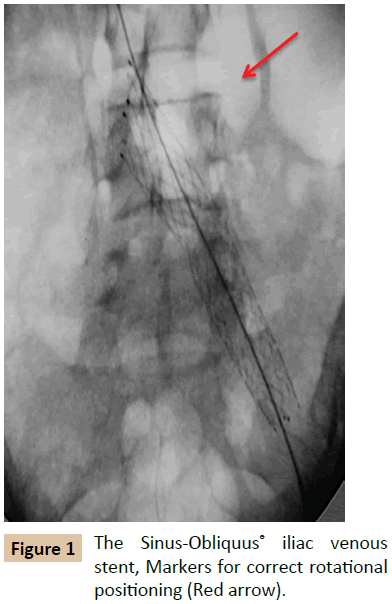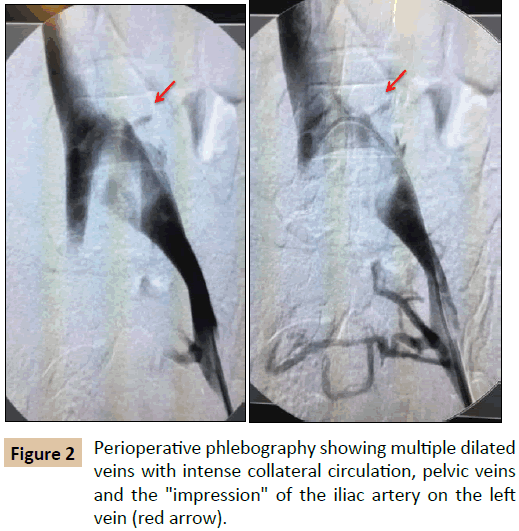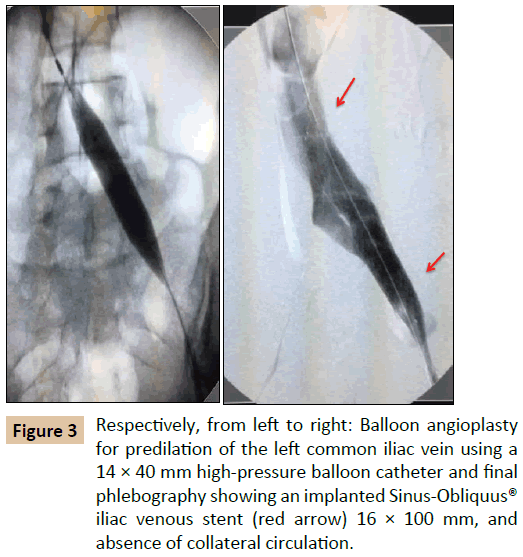New Generation Venous Stent to Treat May-Thurner Syndrome
Paulo Eduardo Ocke Reis
DOI10.21767/2573-4482.100056
Department of Specialized and General Surgery, Fluminense Federal University, Rio de Janeiro, Brazil
- *Corresponding Author:
- Paulo Eduardo Ocke Reis
Department of Specialized and General Surgery
Fluminense Federal University, Rio de Janeiro, Brazil.
Tel: +55 21 2629-5000
E-mail: vascular@pauloocke.com.br
Received date: July 31, 2017; Accepted date: August 09, 2017; Published date: August 14, 2017
Citation: Reis PEO (2017) New Generation Venous Stent to Treat May-Thurner Syndrome. J Vasc Endovasc Surg. 2:23 doi: 10.21767/2573-4482.100056
Editorial
May-Thurner Syndrome (MTS) is an uncommon cause of venous obstruction related to focal external compression, it is characterized by compression of the left common iliac vein by the right common iliac artery and, when such anatomical change causes symptoms that may impair the patients’ health related quality of life, treatment is indicated [1-5]. Currently we opted for endovascular treatment with satisfactory outcomes, for it resolves the symptoms by recanalization of the venous system [1-4].
The Sinus-Obliquus® iliac venous stent (Optimed, Germany) is a self-expanding oblique hybrid nitinol stent to treat MTS. The stent has a proximal closed-cell section that provides high radial force at the blocked site; with an oblique design (35°) at the proximal end prevents jailing of the contralateral iliac vein or vena cava occlusion [3]. The open-cell distal segment affords flexibility and less radial force to better accommodate the curved anatomy of iliac vein (Figure 1) [3,4].
MTS can generate symptoms such as pain, edema, varicose veins, ulcer and deep venous thrombosis. In 1956, May and Thurner, in a corpse study, described the physiopathology of the disease at where hypertrophic alterations observed in the intima were associated with chronic mechanical stress, induced by the pulsations of the right common iliac artery on the common iliac vein left against the vertebra lumbar [4-6]. In 1965, Cockett and Thomas described the syndrome compression of the iliac vein correlating the symptoms, described previously by May and Thurner [4-7]. Since then, treatment of this syndrome has been sharing opinions about conservative treatment or surgical approach, especially after the advent of Endovascular treatment [1-5]. Current endovascular technique brings excellent results in the recanalization of the iliac venous system, in that group of patients with exuberant symptomatology, subjecting the patient to minimal surgical trauma [1-5]. See an example of using the Sinus-Obliquus® iliac venous stent, in a patient with symptomatic MTS, successfully treated by venous balloon angioplasty and stent placement (Figures 2 and 3).
Figure 3: Respectively, from left to right: Balloon angioplasty for predilation of the left common iliac vein using a 14 × 40 mm high-pressure balloon catheter and final phlebography showing an implanted Sinus-Obliquus® iliac venous stent (red arrow) 16 × 100 mm, and absence of collateral circulation.
References
- Cunha Junior JR, Neves DQ, Ocke Reis PE (2011) Tratamento endovascular da sindrome de compressao da veia iliaca (May- Thurner)–relato de caso. J Vasc Bras 10: 1-5.
- Raju S, Owen S, Neglen P (2002) The clinical impact of iliac venous stents in the management of chronic venous insufficiency. J Vasc Surg 35: 8-15.
- Stuck AK, Kunz S, Baumgartner I (2016) Patency and clinical outcomes of a dedicated, self-expanding, hybrid oblique stent used in the treatment of common iliac vein compression. J Endovasc Ther pp: 1-8.
- https://www.leipzig-interventional-course.com/media-library/linc-2015/live-cases/
- Kibbe M, Ujiki M, Goodwin A (2004) Iliac vein compression in an asymptomatic patient population. J Vasc Surg 39: 937-943.
- May R, Thurner J (1957) The cause of the predominantly sinistral occurrence of thrombosis of the pelvic veins. Angiology 8: 419-427.
- Cockett FB, Thomas ML (1965) The iliac compression syndrome. Br J Surg 52: 816-821.
Open Access Journals
- Aquaculture & Veterinary Science
- Chemistry & Chemical Sciences
- Clinical Sciences
- Engineering
- General Science
- Genetics & Molecular Biology
- Health Care & Nursing
- Immunology & Microbiology
- Materials Science
- Mathematics & Physics
- Medical Sciences
- Neurology & Psychiatry
- Oncology & Cancer Science
- Pharmaceutical Sciences



